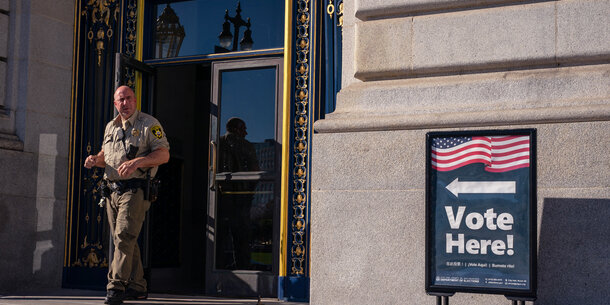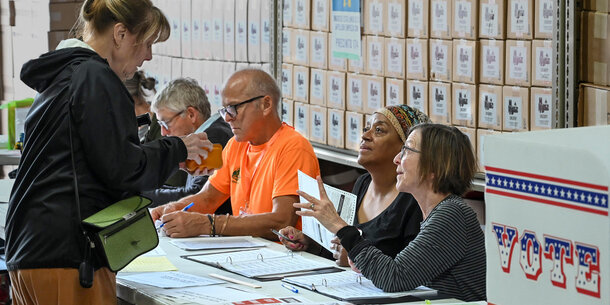“A national embarrassment.” 1 “A disaster.” 2 “Wins at screwing up.” 3 These were just a few assessments of the New York City Board of Elections (NYC BOE) after its most recent in a long history of errors. The agency had mistakenly counted approximately 135,000 test ballots in a preliminary announcement of the June 2021 mayoral primary results. 4 It quickly caught the slip, but the episode only cemented the agency’s reputation for being unable to run a major election without causing some debacle.
The board’s string of failures includes more serious ones that have disenfranchised thousands of voters, from hours-long lines and untraceable absentee ballots in 2020 to widespread machine breakdowns in 2018 to the illegal purge of more than 200,000 voters from the rolls before the 2016 presidential primary. Accounts of agency mismanagement that has disenfranchised voters, 5 along with calls for reform from politicians, advocates, and the media, go back decades. 6 And yet, little seems to change.
This report seeks to answer the question “why?” Why have the repeated public failures, lawsuits, government investigations, civic activism, and media attention failed to substantially improve the agency’s performance? And what can be done to change that?
For the last year, we have delved deep into the workings of the NYC BOE, examined its failures, and compared its performance, structure, and processes to other large boards of elections around the country. 7 What we found is striking. Among large, diverse election jurisdictions, New York City is an extreme outlier in five critical areas: its decisional structure; how its leadership is appointed and staff are hired; its training requirements; who holds the ultimate accountability authority for the agency; and its standards for information sharing. (See chart, “New York City’s Unique Election Administration Practices and Structure Promote Dysfunction,” page 6.)
These systemic defects explain the agency’s uniquely poor track record more than human error, the city’s size, or the complexity of new voting policies. To break the NYC BOE’s cycle of failure, the state legislature, whose laws govern all boards of elections in the state, must enact a comprehensive, systemic redesign of the agency.
The NYC BOE’s flaws — and solutions for addressing them — are outlined below.
Decisional Structure
The NYC BOE’s excessively diffuse decisional structure results in inefficiency and disparities. With ten commissioners — one Democrat and one Republican from each of the city’s five counties, each wielding equal power — the agency’s leadership is far larger and more diffuse than that of any other major metropolitan election jurisdiction in the country.
Impact: Among other problems, the large number of nominating bodies means that no one person is responsible for the commissioners’ appointments (or failures). The county-based, equally weighted decisional structure may also disadvantage residents of more populous and diverse counties in accessing basic resources, such as adequate numbers of polling sites. To take one example of how inequitably resources can be distributed under this system, Staten Island has more than twice as many full-time employees per registered voter as Brooklyn.8
Solution: Streamline operations by reducing the number of commissioners from ten to four and untether them from geographical subdivisions.
Appointments and Hiring
The lack of transparent, merit-based selection standards, from commissioners down through the ranks, enables patronage and poor performance. Currently, political insiders select both NYC BOE commissioners and staffers behind the scenes and based on party machine connections rather than election administration qualifications. The law and selection process require no experience or training of commissioners or executive staff before or after they take office. The only requirements are that commissioners are registered to a major party in the county they represent and that they not hold or run for public office.9
Impact: Quality election administration is too often an afterthought when selection and advancement depend on political connections. The primacy of political party interests over voter interests can go so far as to risk disenfranchisement, as when the NYC BOE in 2019 sued to block a mayoral program’s language interpreters from the polls, in part because the translators might not satisfy what the board argued was a requirement under New York State law: bipartisan teams, one Republican and one Democrat, wherever they were deployed.10
Solutions:
- Require the local appointing authority — the New York City Council — to conduct a transparent, merit-based process for selecting commissioners.
- Require commissioners to conduct nationwide searches for top executive staff, and require public, detailed, and broadly disseminated job postings for all board positions.
- Strike the current requirement in state statute that employees throughout the agency reflect equal representation of the two major political parties.
Training
Insufficient training of leadership and staff impairs the NYC BOE’s ability to adequately serve voters. There is no legal requirement for agency leadership to undergo training, and staff training does not keep pace with changes in the law.
Impact: From illegal voter list purges to widespread poll worker error to long lines and inaccessible poll sites for voters with disabilities due to poor planning, voters suffer countless harms when leadership and staff lack sufficient expertise. These problems can have a disenfranchising or discriminatory effect on working people who cannot afford to wait or people with accessibility needs.
Solution: Require that commissioners and executive staff complete election law and administration training and improve rank-and-file trainings.
Accountability
NYC voters have no effective path to hold their BOE accountable for persistent failures. City voters’ most direct representatives — the city council and citywide elected officials, including the mayor — lack the authority to remove commissioners, even though the city council has the power to appoint them. State law gives only the governor this authority. 11 It appears that no governor has ever exercised this power, in spite of the agency’s extensive history of poor leadership.
Impact: The NYC BOE’s leaders have little reason to improve the agency when they can retain power for years, even after disastrous outcomes. In this report, we document the agency’s major failures throughout the last decade, including long lines, machine meltdowns, voter roll purges, physically inaccessible poll sites, and inequitable language access. Each of these fiascoes has disenfranchised a large number of voters or greatly undermined public faith in the board itself, and yet rarely are commissioners or top staff replaced. The lack of accountability has led to a cycle well known to the New York voting public: failure, exposure, public criticisms, calls for accountability, and expressions of frustration by political leaders that they have no power to change things, followed by inaction and the inevitable next debacle.
Solution: Give locally accountable elected officials the power to remove commissioners, with review by the courts for just cause.
Information Sharing
The NYC BOE’s failure to share timely, usable information with the public hampers voters and inhibits its own improvement. The NYC BOE has failed repeatedly to convey information to the public that is crucial to be able to vote, and it provides limited access to election data that would enable evaluation and improvement of its performance over time.
Impact: The agency’s failure to provide information to voters, such as timely notices of the status of their absentee ballots, can result in confusion about how to vote, risking disenfranchisement. The lack of timely, granular, public, and user-friendly election data — such as rates of and reasons for ballot rejections, affidavit (provisional) ballot usage rates, and average wait times per poll site — hinders prompt public scrutiny and also the possibility of improvement through collaboration with outside experts and other election agencies.
Solutions:
- Improve communications with voters, including by requiring the agency’s absentee ballot tracker to be timely updated.
- Require the agency to track and publicly report key voting and election administration data in an accessible, frequently updated form.
- Establish a working group that includes state and local officials and board of elections representatives to provide feedback on and plan implementation of legislation.
The good news is that all of the solutions we detail in this report can be adopted immediately. Many observers mistakenly assume that reform on this scale would require amending the state constitution, a part of which has served as an excuse for political manipulation of the agency. 12 An amendment is no small undertaking, as it involves passage by two consecutive legislatures and then by a majority of state voters in a ballot referendum. 13 The changes that this study urges for the NYC BOE require only the will of the state legislature to enact traditional legislation. But it will be worth studying whether significant improvements to boards of elections statewide, which together consistently keep New York in the nation’s lowest rankings for election administration, warrant constitutional change.14
In the meantime, mandating the structural reforms detailed in this study, gleaned from best practices across the country, will vastly improve the NYC BOE’s service and accountability to voters and provide some solutions that could apply elsewhere in the state. Indeed, some officials and staff within the NYC BOE itself say they are eager for and open to improvement. 15 Lawmakers should adopt these reforms without delay.
The need to fix the NYC BOE has never been more urgent. Of course, the city’s 5.5 million registered voters — more than there are in most states 16 — have always deserved better. But in this era of the Big Lie, when merchants of misinformation seize any excuse to shake the nation’s trust in elections and election officials face unprecedented threats, 17 curing the infamous dysfunction of the NYC BOE is critical for the entire nation.18
Endnotes
-
1
David Klepper and Jennifer Peltz, “Vote Mistake Not the First Flub for NYC Board of Elections,” Associated Press, July 1, 2021, https://apnews.com/article/elections-government-and-politics-d29c384522ca1cb7034e03aa03189c60 (quoting Senate Majority Leader Andrea Stewart-Cousins). -
2
New York Times Editorial Board, “The N.Y.C. Elections Board Is a Disaster. This Is the Last Straw,” New York Times, June 30, 2021, https://www.nytimes.com/2021/06/30/opinion/nyc-mayor-election-boe-votes.html. -
3
Nia Prater and Chas Danner, “The New York City Board of Elections Wins at Screwing Up,” New York Magazine, June 30, 2021, https://nymag.com/intelligencer/2021/06/the-new-york-city-board-of-election-wins-at-screwing-up.html. -
4
NYC Board of Elections (@BOENYC), Twitter, June 29, 2021, 10:34 p.m., https://twitter.com/BOENYC/status/1410064145064599554 (NYC BOE statement on tabulation error). -
5
Ronald Hayduk, Gatekeepers to the Franchise: Shaping Election Administration in New York (Dekalb: Northern Illinois University Press, 2005), 52 (during the 1912 primary election, according to a report by New York City Commissioner of Accounts Raymond B. Fosdick, in “many of the election districts no ballots were received at all, while in others they were received too late to be of service. The result was that thousands of voters were effectively disenfran- chised. . . . It appears that the greatest inconvenience was felt in Brooklyn.”). -
6
Brian M. Rosenthal and Michael Rothfeld, “Inside Decades of Nepotism and Bungling at the N.Y.C. Elections Board,” New York Times, October 26, 2020, https://www.nytimes.com/2020/10/26/nyregion/nyc-voting-election-board.html (recounting calls for reform from as early as 1940). -
7
The findings in this report — of the nature and consequences of these systemic flaws and of the potential for progress in fixing them — derive not merely from study of law, policy, investigative reports, and court decisions. They also reflect the perspectives and lessons gleaned from interviews with current and former elections officials from 10 major elections jurisdictions across the country. In addition, we interviewed two current officials at the NYC BOE who spoke on the condition of anonymity (hereinafter NYC BOE Official A and NYC BOE Official B) and a New York City government official with direct knowledge of the NYC BOE’s operations who asked to remain anonymous (hereinafter NYC Government Official A). We also interviewed two former NYC BOE commissioners, one of whom requested to speak anonymously. The Brennan Center emailed each of the 10 current commissioners a list of questions but as of this writing has not received responses. This report also draws from essential insights contributed by experienced advocates and civic leaders, many of whom are fellow members of the Let NY Vote coalition that has achieved a historic spate of voting reforms just since 2019. See “Wins,” Let NY Vote (website), accessed August 9, 2021, https://letnyvote.org/wins. -
8
City of New York, Adopted Budget Fiscal Year 2022 Supporting Schedules, accessed July 26, 2021, 116–18, https://www1.nyc.gov/assets/omb/downloads/pdf/ss6–21.pdf; and New York State Board of Elections, Albany, NY (hereinafter NYS BOE), “Enrollment by County,” last modified February 21, 2021, https://www.elections.ny.gov/EnrollmentCounty.html. -
9
N.Y. Elec. Law § 3–200(4), (6) (McKinney 2021) (listing qualifica- tions for commissioners. Some public office exceptions exist, including acting as a commissioner of deeds or member of a community board). -
10
Plaintiff’s Complaint for Injunctive and Declaratory Relief at ¶ 13, Board of Elections in City of New York v. Mostofi, No. 700001/19 (Sup. Ct. Kings Cnty. 2019) (“The city-funded MOIA interpreters do not operate in bi-partisan teams as required under the Election Law.”); id. at ¶ 36 (“[N]or do the city-funded interpreters operate in bi-partisan teams as required under the Election Law.”); and Board of Elections in City of New York v. Mostofi, 65 Misc. 3d 876, 881–82, 886–87, 108 N.Y.S. 3d 819 (Sup. Ct. Kings Cnty. 2019). -
11
N.Y. Elec. Law § 3–200(7) (McKinney 2021). -
12
See N.Y. Const. art. II, § 8. See also Rachel Holliday Smith, “How to Reform New York City’s Board of Elections (For Real This Time),” The City, October 26, 2020, https://www.thecity.nyc/2020/10/26/21535643/how-to-reform-new-york-city-board-of-elections(“[M]ost advocates say the real power to force change at the BOE rests in reshaping the state constitution to remove the partisan requirement for the Board.”). -
13
N.Y. Const. art. XIX, § 1. -
14
“Elections Performance Index,” MIT Election Data & Science Lab, accessed August 3, 2021, https://elections.mit.edu/#/data/map. -
15
NYC BOE Official A and Official B, conversation with Brennan Center, July 8, 2021. -
16
NYS BOE, “Enrollment by County”; and U.S. Census Bureau, “Voting and Registration in the Election of November 2020—Table 4a, Reported Voting and Registration for States: November 2020,” last modified April 2021, https://www.census.gov/data/tables/time-series/demo/voting-and-registration/p20–585.html. -
17
See generally Brennan Center for Justice and Bipartisan Policy Center, Election Officials Under Attack, June 16, 2021, https://www.brennancenter.org/our-work/policy-solutions/election-officials-under-attack. -
18
Philip Bump, “New York’s Mayoral Election Is a Mess. This Doesn’t Somehow Prove Donald Trump Right,” Washington Post, June 30, 2021, https://www.washingtonpost.com/politics/2021/06/30/new-yorks-mayoral-election-is-mess-this-doesnt-somehow-prove-donald-trump-right/.







